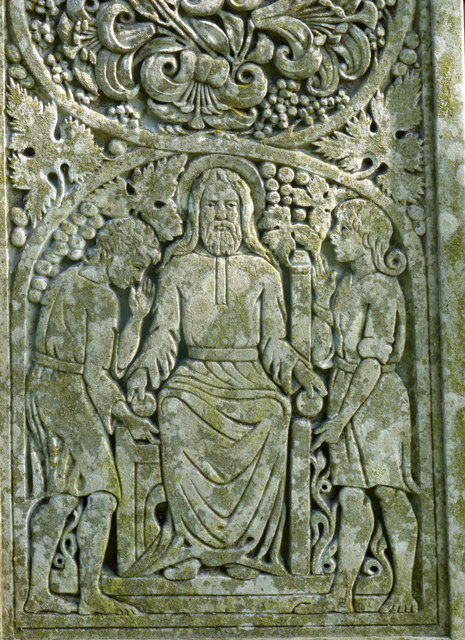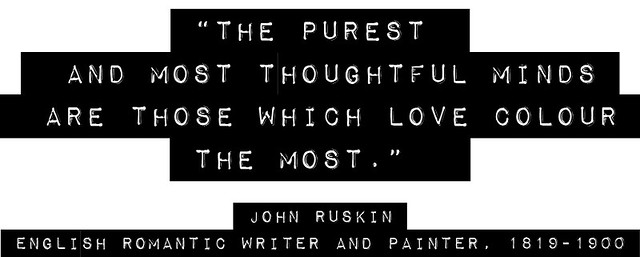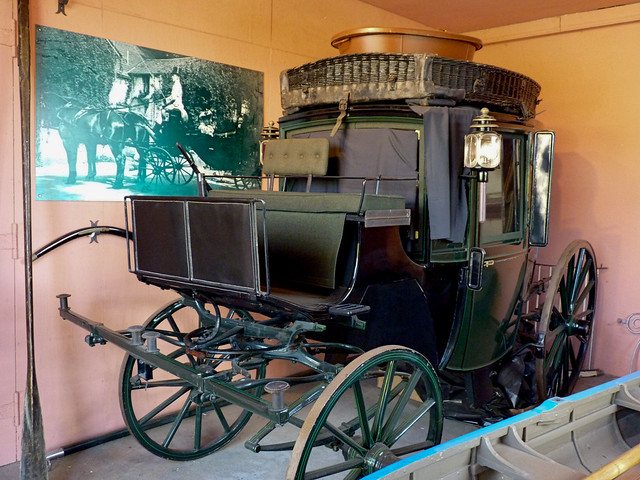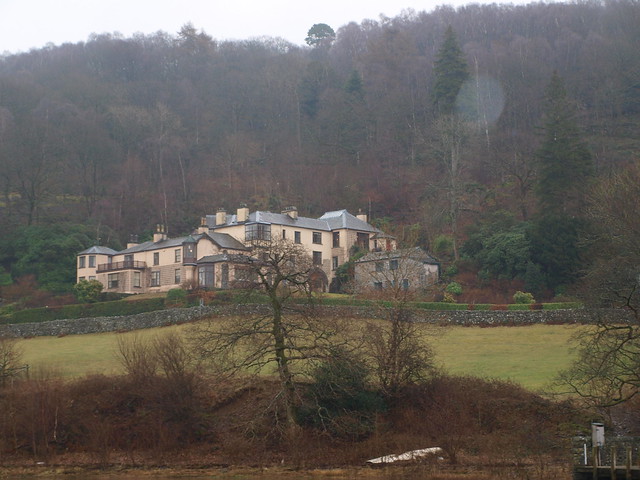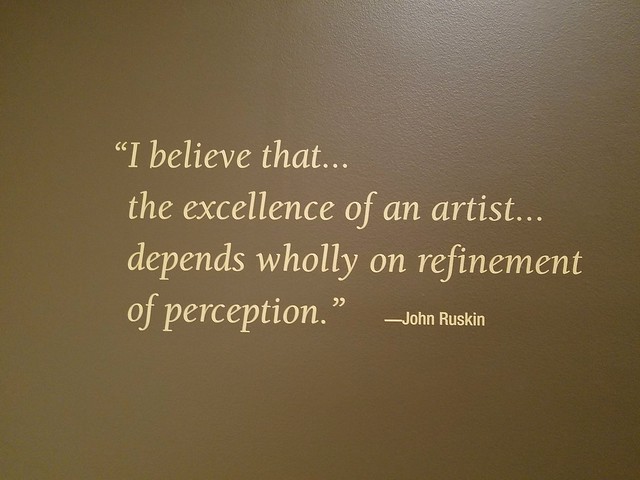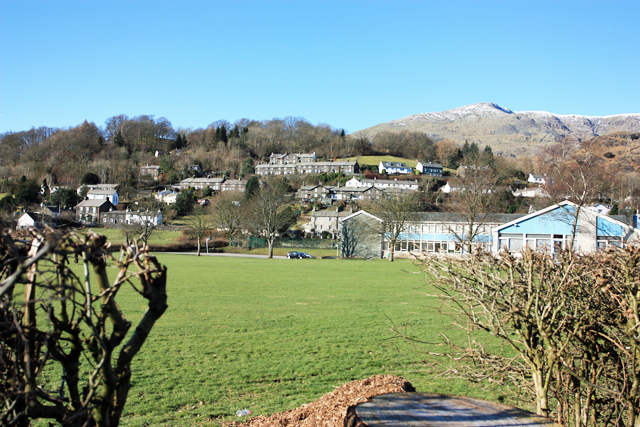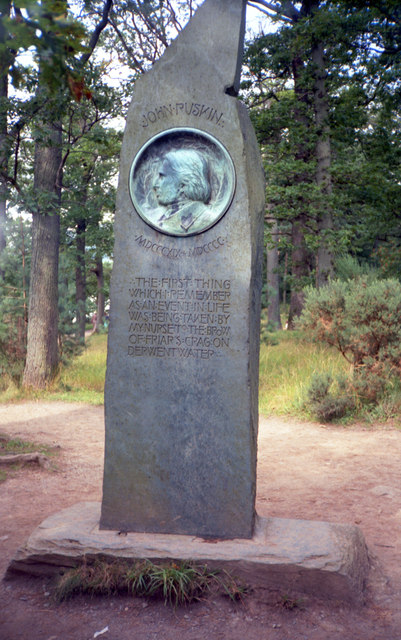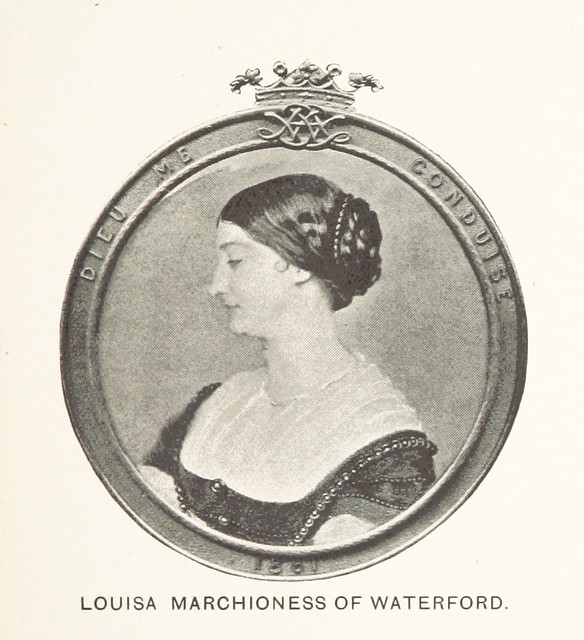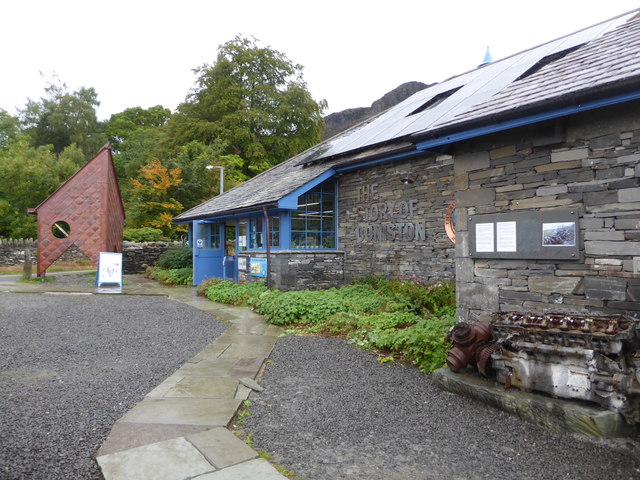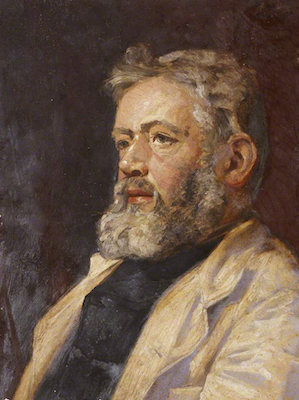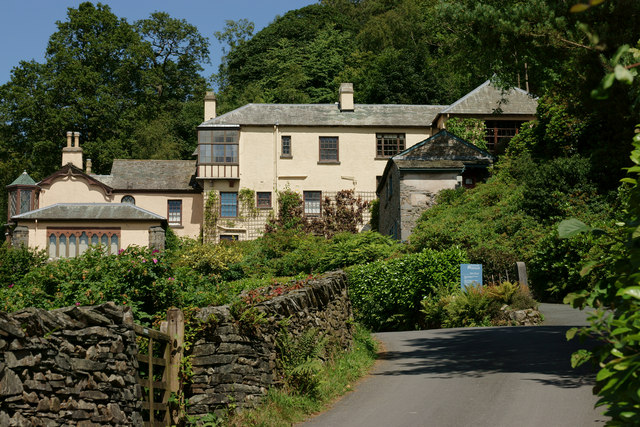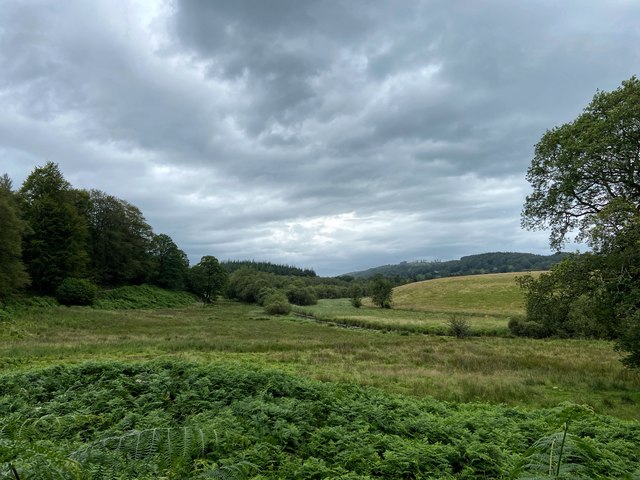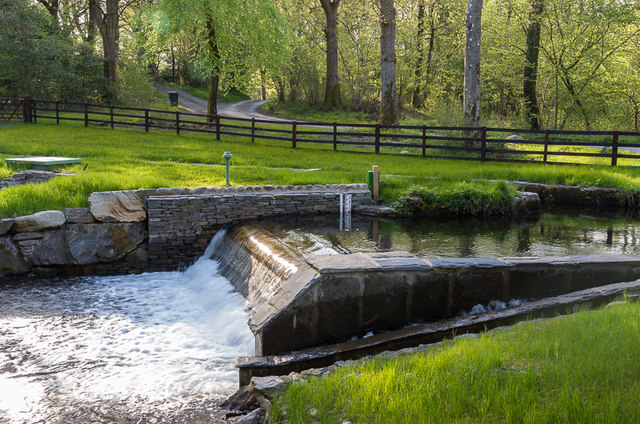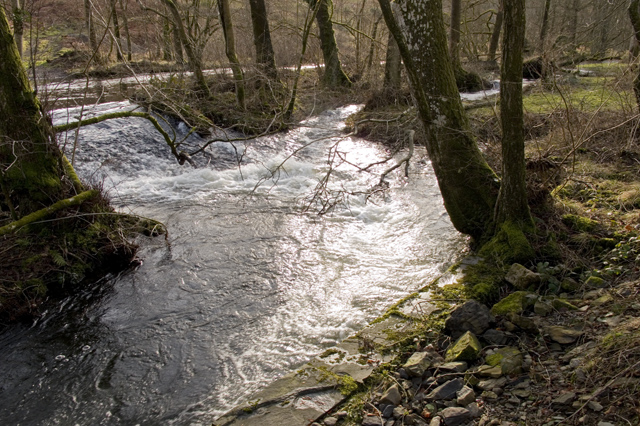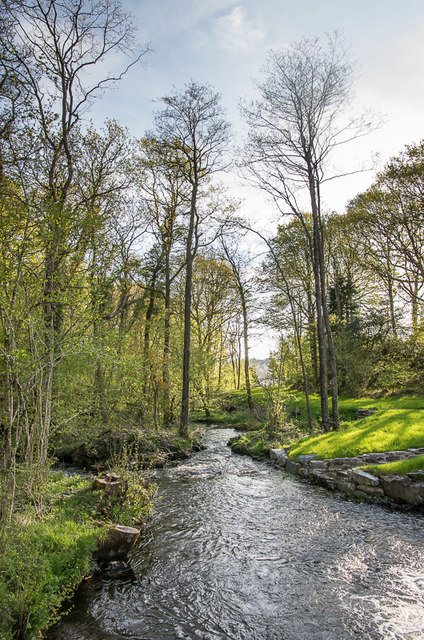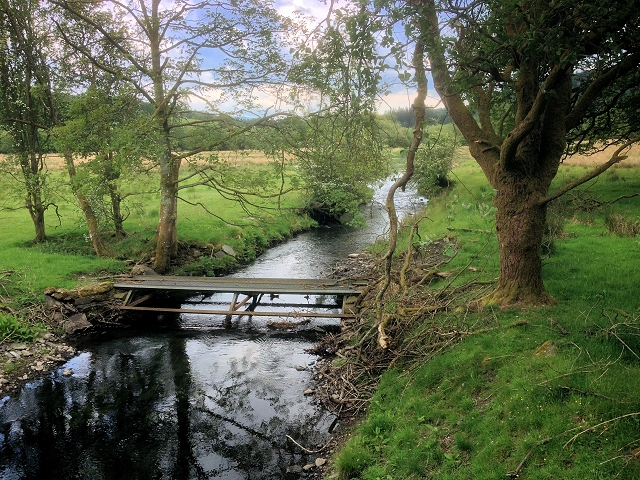Topics > People in History > John Ruskin (1819 - 1900)
John Ruskin (1819 - 1900)
John Ruskin (1819 - 1900) was one of the leading visionaries and thinkers of the Victorian era.
John Ruskin (8 February 1819 – 20 January 1900) was an English writer, philosopher and art critic of the Victorian era. He wrote on subjects as varied as geology, architecture, myth, ornithology, literature, education, botany and political economy.
Ruskin's writing styles and literary forms were equally varied. He wrote essays and treatises, poetry and lectures, travel guides and manuals, letters and even a fairy tale. He also made detailed sketches and paintings of rocks, plants, birds, landscapes, architectural structures and ornamentation. The elaborate style that characterised his earliest writing on art gave way in time to plainer language designed to communicate his ideas more effectively. In all of his writing, he emphasised the connections between nature, art and society.
Ruskin was hugely influential in the latter half of the 19th century and up to the First World War. After a period of relative decline, his reputation has steadily improved since the 1960s with the publication of numerous academic studies of his work. Today, his ideas and concerns are widely recognised as having anticipated interest in environmentalism, sustainability and craft.
Ruskin first came to widespread attention with the first volume of Modern Painters (1843), an extended essay in defence of the work of J. M. W. Turner in which he argued that the principal role of the artist is "truth to nature". From the 1850s, he championed the Pre-Raphaelites, who were influenced by his ideas. His work increasingly focused on social and political issues. Unto This Last (1860, 1862) marked the shift in emphasis. In 1869, Ruskin became the first Slade Professor of Fine Art at the University of Oxford, where he established the Ruskin School of Drawing. In 1871, he began his monthly "letters to the workmen and labourers of Great Britain", published under the title Fors Clavigera (1871–1884). In the course of this complex and deeply personal work, he developed the principles underlying his ideal society. As a result, he founded the Guild of St George, an organisation that endures today.
Early life (1819–1846)
Genealogy
Ruskin was the only child of first cousins. His father, John James Ruskin (1785–1864), was a sherry and wine importer, founding partner and de facto business manager of Ruskin, Telford and Domecq (see Allied Domecq). John James was born and brought up in Edinburgh, Scotland, to a mother from Glenluce and a father originally from Hertfordshire. His wife, Margaret Cock (1781–1871), was the daughter of a publican in Croydon. She had joined the Ruskin household when she became companion to John James's mother, Catherine.
John James had hoped to practise law, and was articled as a clerk in London. His father, John Thomas Ruskin, described as a grocer (but apparently an ambitious wholesale merchant), was an incompetent businessman. To save the family from bankruptcy, John James, whose prudence and success were in stark contrast to his father, took on all debts, settling the last of them in 1832. John James and Margaret were engaged in 1809, but opposition to the union from John Thomas, and the problem of his debts, delayed the couple's wedding. They finally married, without celebration, in 1818. John James died on 3 March 1864 and is buried in the churchyard of St John the Evangelist, Shirley, Croydon.
Childhood and education
John Ruskin by James Northcote.jpg|thumb|Ruskin as a young child, painted by James Northcote
Ruskin was born on 8 February 1819 at 54 Hunter Street, Brunswick Square, London (demolished 1969), south of St Pancras railway station. His childhood was shaped by the contrasting influences of his father and mother, both of whom were fiercely ambitious for him. John James Ruskin helped to develop his son's Romanticism. They shared a passion for the works of Byron, Shakespeare and especially Walter Scott. They visited Scott's home, Abbotsford, in 1838, but Ruskin was disappointed by its appearance. Margaret Ruskin, an evangelical Christian, more cautious and restrained than her husband, taught young John to read the Bible from beginning to end, and then to start all over again, committing large portions to memory. Its language, imagery and parables had a profound and lasting effect on his writing. He later wrote:
Ruskin's childhood was spent from 1823 at 28 Herne Hill (demolished ), near the village of Camberwell in South London. He had few friends of his own age, but it was not the friendless and toyless experience he later said it was in his autobiography, Praeterita (1885–89). He was educated at home by his parents and private tutors, including Congregationalist preacher Edward Andrews, whose daughters, Mrs Eliza Orme and Emily Augusta Patmore were later credited with introducing Ruskin to the Pre-Raphelite Brotherhood.
From 1834 to 1835 he attended the school in Peckham run by the progressive evangelical Thomas Dale (1797–1870). Ruskin heard Dale lecture in 1836 at King's College, London, where Dale was the first Professor of English Literature. Ruskin went on to enroll and complete his studies at King's College, where he prepared for Oxford under Dale's tutelage.
Travel
Ruskin was greatly influenced by the extensive and privileged travels he enjoyed in his childhood. It helped to establish his taste and augmented his education. He sometimes accompanied his father on visits to business clients at their country houses, which exposed him to English landscapes, architecture and paintings. Family tours took them to the Lake District (his first long poem, Iteriad, was an account of his tour in 1830) and to relatives in Perth, Scotland. As early as 1825, the family visited France and Belgium. Their continental tours became increasingly ambitious in scope: in 1833 they visited Strasbourg, Schaffhausen, Milan, Genoa and Turin, places to which Ruskin frequently returned. He developed a lifelong love of the Alps, and in 1835 visited Venice for the first time, that 'Paradise of cities' that provided the subject and symbolism of much of his later work.
These tours gave Ruskin the opportunity to observe and record his impressions of nature. He composed elegant, though mainly conventional poetry, some of which was published in Friendship's Offering. His early notebooks and sketchbooks are full of visually sophisticated and technically accomplished drawings of maps, landscapes and buildings, remarkable for a boy of his age. He was profoundly affected by Samuel Rogers's poem Italy (1830), a copy of which was given to him as a 13th birthday present; in particular, he deeply admired the accompanying illustrations by J. M. W. Turner. Much of Ruskin's own art in the 1830s was in imitation of Turner, and of Samuel Prout, whose Sketches Made in Flanders and Germany (1833) he also admired. His artistic skills were refined under the tutelage of Charles Runciman, Copley Fielding and J. D. Harding.
First publications
Ruskin's journeys also provided inspiration for writing. His first publication was the poem "On Skiddaw and Derwent Water" (originally entitled "Lines written at the Lakes in Cumberland: Derwentwater" and published in the Spiritual Times) (August 1829). In 1834, three short articles for Loudon's Magazine of Natural History were published. They show early signs of his skill as a close "scientific" observer of nature, especially its geology.
From September 1837 to December 1838, Ruskin's The Poetry of Architecture was serialised in Loudon's Architectural Magazine, under the pen name "Kata Phusin" (Greek for "According to Nature"). It was a study of cottages, villas, and other dwellings centred on a Wordsworthian argument that buildings should be sympathetic to their immediate environment and use local materials. It anticipated key themes in his later writings. In 1839, Ruskin's "Remarks on the Present State of Meteorological Science" was published in Transactions of the Meteorological Society.
Oxford
In Michaelmas 1836, Ruskin matriculated at the University of Oxford, taking up residence at Christ Church in January of the following year. Enrolled as a gentleman-commoner, he enjoyed equal status with his aristocratic peers. Ruskin was generally uninspired by Oxford and suffered bouts of illness. Perhaps the greatest advantage of his time there was in the few, close friendships he made. His tutor, the Rev Walter Lucas Brown, always encouraged him, as did a young senior tutor, Henry Liddell (later the father of Alice Liddell) and a private tutor, the Rev Osborne Gordon. He became close to the geologist and natural theologian, William Buckland. Among his fellow-undergraduates, Ruskin's most important friends were Charles Thomas Newton and Henry Acland.
His most noteworthy success came in 1839 when, at the third attempt, he won the prestigious Newdigate Prize for poetry (Arthur Hugh Clough came second). He met William Wordsworth, who was receiving an honorary degree, at the ceremony.
Ruskin's health was poor and he never became independent from his family during his time at Oxford. His mother took lodgings on High Street, where his father joined them at weekends. He was devastated to hear that his first love, Adèle Domecq, the second daughter of his father's business partner, had become engaged to a French nobleman. In April 1840, whilst revising for his examinations, he began to cough blood, which led to fears of consumption and a long break from Oxford travelling with his parents.
Before he returned to Oxford, Ruskin responded to a challenge that had been put to him by Effie Gray, whom he later married: the twelve-year-old Effie had asked him to write a fairy story. During a six-week break at Leamington Spa to undergo Dr Jephson's (1798–1878) celebrated salt-water cure, Ruskin wrote his only work of fiction, the fable The King of the Golden River (not published until December 1850 (but imprinted 1851), with illustrations by Richard Doyle). A work of Christian sacrificial morality and charity, it is set in the Alpine landscape Ruskin loved and knew so well. It remains the most translated of all his works. Back at Oxford, in 1842 Ruskin sat for a pass degree, and was awarded an uncommon honorary double fourth-class degree in recognition of his achievements.
Modern Painters I (1843)
For much of the period from late 1840 to autumn 1842, Ruskin was abroad with his parents, mainly in Italy. His studies of Italian art were chiefly guided by George Richmond, to whom the Ruskins were introduced by Joseph Severn, a friend of Keats (whose son, Arthur Severn, later married Ruskin's cousin, Joan). He was galvanised into writing a defence of J. M. W. Turner when he read an attack on several of Turner's pictures exhibited at the Royal Academy. It recalled an attack by the critic Rev John Eagles in Blackwood's Magazine in 1836, which had prompted Ruskin to write a long essay. John James had sent the piece to Turner, who did not wish it to be published. It finally appeared in 1903.
Before Ruskin began Modern Painters, John James Ruskin had begun collecting watercolours, including works by Samuel Prout and Turner. Both painters were among occasional guests of the Ruskins at Herne Hill, and 163 Denmark Hill (demolished 1947) to which the family moved in 1842.
What became the first volume of Modern Painters (1843), published by Smith, Elder & Co. under the anonymous authority of "A Graduate of Oxford", was Ruskin's answer to Turner's critics. Ruskin controversially argued that modern landscape painters—and in particular Turner—were superior to the so-called "Old Masters" of the post-Renaissance period. Ruskin maintained that, unlike Turner, Old Masters such as Gaspard Dughet (Gaspar Poussin), Claude, and Salvator Rosa favoured pictorial convention, and not "truth to nature". He explained that he meant "moral as well as material truth". The job of the artist is to observe the reality of nature and not to invent it in a studioto render imaginatively on canvas what he has seen and understood, free of any rules of composition. For Ruskin, modern landscapists demonstrated superior understanding of the "truths" of water, air, clouds, stones, and vegetation, a profound appreciation of which Ruskin demonstrated in his own prose. He described works he had seen at the National Gallery and Dulwich Picture Gallery with extraordinary verbal felicity.
Although critics were slow to react and the reviews were mixed, many notable literary and artistic figures were impressed with the young man's work, including Charlotte Brontë and Elizabeth Gaskell. Suddenly Ruskin had found his métier, and in one leap helped redefine the genre of art criticism, mixing a discourse of polemic with aesthetics, scientific observation and ethics. It cemented Ruskin's relationship with Turner. After the artist died in 1851, Ruskin catalogued nearly 20,000 sketches that Turner gave to the British nation.
1845 tour and Modern Painters II (1846)
Ruskin toured the continent with his parents again in 1844, visiting Chamonix and Paris, studying the geology of the Alps and the paintings of Titian, Veronese and Perugino among others at the Louvre. In 1845, at the age of 26, he undertook to travel without his parents for the first time. It provided him with an opportunity to study medieval art and architecture in France, Switzerland and especially Italy. In Lucca he saw the Tomb of Ilaria del Carretto by Jacopo della Quercia, which Ruskin considered the exemplar of Christian sculpture (he later associated it with the then object of his love, Rose La Touche). He drew inspiration from what he saw at the Campo Santo in Pisa, and in Florence. In Venice, he was particularly impressed by the works of Fra Angelico and Giotto in St Mark's Cathedral, and Tintoretto in the Scuola di San Rocco, but he was alarmed by the combined effects of decay and modernisation on the city: "Venice is lost to me", he wrote. It finally convinced him that architectural restoration was destruction, and that the only true and faithful action was preservation and conservation.
Drawing on his travels, he wrote the second volume of Modern Painters (published April 1846). The volume concentrated on Renaissance and pre-Renaissance artists rather than on Turner. It was a more theoretical work than its predecessor. Ruskin explicitly linked the aesthetic and the divine, arguing that truth, beauty and religion are inextricably bound together: "the Beautiful as a gift of God". In defining categories of beauty and imagination, Ruskin argued that all great artists must perceive beauty and, with their imagination, communicate it creatively by means of symbolic representation. Generally, critics gave this second volume a warmer reception, although many found the attack on the aesthetic orthodoxy associated with Joshua Reynolds difficult to accept. In the summer, Ruskin was abroad again with his father, who still hoped his son might become a poet, even poet laureate, just one among many factors increasing the tension between them.
Middle life (1847–1869)
Marriage to Effie Gray
During 1847, Ruskin became closer to Effie Gray, the daughter of family friends. It was for her that Ruskin had written The King of the Golden River. The couple were engaged in October. They married on 10 April 1848 at her home, Bowerswell, in Perth, once the residence of the Ruskin family. It was the site of the suicide of John Thomas Ruskin (Ruskin's grandfather). Owing to this association and other complications, Ruskin's parents did not attend. The European Revolutions of 1848 meant that the newlyweds' earliest travels together were restricted, but they were able to visit Normandy, where Ruskin admired the Gothic architecture.
Their early life together was spent at 31 Park Street, Mayfair, secured for them by Ruskin's father (later addresses included nearby 6 Charles Street, and 30 Herne Hill). Effie was too unwell to undertake the European tour of 1849, so Ruskin visited the Alps with his parents, gathering material for the third and fourth volumes of Modern Painters. He was struck by the contrast between the Alpine beauty and the poverty of Alpine peasants, stirring his increasingly sensitive social conscience.
The marriage was unhappy, with Ruskin reportedly being cruel to Effie and distrustful of her. The marriage was never consummated and was annulled six years later in 1854.
Architecture
Ruskin's developing interest in architecture, and particularly in the Gothic, led to the first work to bear his name, The Seven Lamps of Architecture (1849). It contained 14 plates etched by the author. The title refers to seven moral categories that Ruskin considered vital to and inseparable from all architecture: sacrifice, truth, power, beauty, life, memory and obedience. All would provide recurring themes in his future work. Seven Lamps promoted the virtues of a secular and Protestant form of Gothic. It was a challenge to the Catholic influence of architect A. W. N. Pugin.
The Stones of Venice
In November 1849, Effie and John Ruskin visited Venice, staying at the Hotel Danieli. Their different personalities are thrown into sharp relief by their contrasting priorities. For Effie, Venice provided an opportunity to socialise, while Ruskin was engaged in solitary studies. In particular, he made a point of drawing the Ca' d'Oro and the Doge's Palace, or Palazzo Ducale, because he feared that they would be destroyed by the occupying Austrian troops. One of these troops, Lieutenant Charles Paulizza, became friendly with Effie, apparently with Ruskin's consent. Her brother, among others, later claimed that Ruskin was deliberately encouraging the friendship to compromise her, as an excuse to separate.
Meanwhile, Ruskin was making the extensive sketches and notes that he used for his three-volume work The Stones of Venice (1851–53). Developing from a technical history of Venetian architecture from the Romanesque to the Renaissance, into a broad cultural history, Stones reflected Ruskin's view of contemporary England. It served as a warning about the moral and spiritual health of society. Ruskin argued that Venice had slowly degenerated. Its cultural achievements had been compromised, and its society corrupted, by the decline of true Christian faith. Instead of revering the divine, Renaissance artists honoured themselves, arrogantly celebrating human sensuousness.
The chapter, "The Nature of Gothic" appeared in the second volume of Stones. Praising Gothic ornament, Ruskin argued that it was an expression of the artisan's joy in free, creative work. The worker must be allowed to think and to express his own personality and ideas, ideally using his own hands, rather than machinery.
This was both an aesthetic attack on, and a social critique of, the division of labour in particular, and industrial capitalism in general. This chapter had a profound impact, and was reprinted both by the Christian socialist founders of the Working Men's College and later by the Arts and Crafts pioneer and socialist William Morris.
Pre-Raphaelites
John Everett Millais, William Holman Hunt and Dante Gabriel Rossetti had established the Pre-Raphaelite Brotherhood in 1848. The Pre-Raphaelite commitment to 'naturalism' – "paint[ing] from nature only", depicting nature in fine detail, had been influenced by Ruskin.
Ruskin came into contact with Millais after the artists made an approach to Ruskin through their mutual friend Coventry Patmore. Initially, Ruskin had not been impressed by Millais's Christ in the House of His Parents (1849–50), a painting that was considered blasphemous at the time, but Ruskin wrote letters defending the Pre-Raphaelite Brotherhood to The Times in May 1851. Providing Millais with artistic patronage and encouragement, in the summer of 1853 the artist (and his brother) travelled to Scotland with Ruskin and Effie where, at Glenfinlas, he painted the closely observed landscape background of gneiss rock to which, as had always been intended, he later added Ruskin's portrait.
Millais had painted Effie for The Order of Release, 1746, exhibited at the Royal Academy in 1852. Suffering increasingly from physical illness and acute mental anxiety, Effie was arguing fiercely with her husband and his intense and overly protective parents, and sought solace with her own parents in Scotland. The Ruskin marriage was already fatally undermined as she and Millais fell in love, and Effie left Ruskin, causing a public scandal.
In April 1854, Effie filed her suit of nullity, on grounds of "non-consummation" owing to his "incurable impotency", a charge Ruskin later disputed. Ruskin wrote, "I can prove my virility at once." The annulment was granted in July. Ruskin did not even mention it in his diary. Effie married Millais the following year. The complex reasons for the non-consummation and ultimate failure of the Ruskin marriage are a matter of enduring speculation and debate.
Ruskin continued to support Hunt and Rossetti. He also provided an annuity of £150 in 1855–57 to Elizabeth Siddal, Rossetti's wife, to encourage her art (and paid for the services of Henry Acland for her medical care). Other artists influenced by the Pre-Raphaelites also received both critical and financial support from Ruskin, including John Brett, John William Inchbold, and Edward Burne-Jones, who became a good friend (he called him "Brother Ned"). His father's disapproval of such friends was a further cause of considerable tension between them.
During this period Ruskin wrote regular reviews of the annual exhibitions at the Royal Academy under the title Academy Notes (1855–59, 1875). They were highly influential, capable of making or breaking reputations. The satirical magazine Punch published the lines (24 May 1856), "I paints and paints,/hears no complaints/And sells before I'm dry,/Till savage Ruskin/He sticks his tusk in/Then nobody will buy."
Ruskin was an art-philanthropist: in March 1861 he gave 48 Turner drawings to the Ashmolean in Oxford, and a further 25 to the Fitzwilliam Museum, Cambridge in May. Ruskin's own work was very distinctive, and he occasionally exhibited his watercolours: in the United States in 1857–58 and 1879, for example; and in England, at the Fine Art Society in 1878, and at the Royal Society of Painters in Watercolour (of which he was an honorary member) in 1879. He created many careful studies of natural forms, based on his detailed botanical, geological and architectural observations. Examples of his work include a painted, floral pilaster decoration in the central room of Wallington Hall in Northumberland, home of his friend Pauline Trevelyan. The stained glass window in the Little Church of St Francis Funtley, Fareham, Hampshire is reputed to have been designed by him. Originally placed in the St. Peter's Church Duntisbourne Abbots near Cirencester, the window depicts the Ascension and the Nativity.
Ruskin's theories also inspired some architects to adapt the Gothic style. Such buildings created what has been called a distinctive "Ruskinian Gothic". Through his friendship with Henry Acland, Ruskin supported attempts to establish what became the Oxford University Museum of Natural History (designed by Benjamin Woodward)—which is the closest thing to a model of this style, but still failed to satisfy Ruskin completely. The many twists and turns in the Museum's development, not least its increasing cost, and the University authorities' less than enthusiastic attitude towards it, proved increasingly frustrating for Ruskin.
Ruskin and education
The Museum was part of a wider plan to improve science provision at Oxford, something the University initially resisted. Ruskin's first formal teaching role came about in the mid-1850s, when he taught drawing classes (assisted by Dante Gabriel Rossetti) at the Working Men's College, established by the Christian socialists, Frederick James Furnivall and Frederick Denison Maurice. Although Ruskin did not share the founders' politics, he strongly supported the idea that through education workers could achieve a crucially important sense of (self-)fulfilment. One result of this involvement was Ruskin's Elements of Drawing (1857). He had taught several women drawing, by means of correspondence, and his book represented both a response and a challenge to contemporary drawing manuals. The WMC was also a useful recruiting ground for assistants, on some of whom Ruskin would later come to rely, such as his future publisher, George Allen.
From 1859 until 1868, Ruskin was involved with the progressive school for girls at Winnington Hall in Cheshire. A frequent visitor, letter-writer, and donor of pictures and geological specimens to the school, Ruskin approved of the mixture of sports, handicrafts, music and dancing encouraged by its principal, Miss Bell. The association led to Ruskin's sub-Socratic work, The Ethics of the Dust (1866), an imagined conversation with Winnington's girls in which he cast himself as the "Old Lecturer". On the surface a discourse on crystallography, it is a metaphorical exploration of social and political ideals. In the 1880s, Ruskin became involved with another educational institution, Whitelands College, a training college for teachers, where he instituted a May Queen festival that endures today. (It was also replicated in the 19th century at the Cork High School for Girls.) Ruskin also bestowed books and gemstones upon Somerville College, one of Oxford's first two women's colleges, which he visited regularly, and was similarly generous to other educational institutions for women.
Modern Painters III and IV
Both volumes III and IV of Modern Painters were published in 1856. In MP III Ruskin argued that all great art is "the expression of the spirits of great men". Only the morally and spiritually healthy are capable of admiring the noble and the beautiful, and transforming them into great art by imaginatively penetrating their essence. MP IV presents the geology of the Alps in terms of landscape painting, and their moral and spiritual influence on those living nearby. The contrasting final chapters, "The Mountain Glory" and "The Mountain Gloom" provide an early example of Ruskin's social analysis, highlighting the poverty of the peasants living in the lower Alps.
Public lecturer
In addition to leading more formal teaching classes, from the 1850s Ruskin became an increasingly popular public lecturer. His first public lectures were given in Edinburgh, in November 1853, on architecture and painting. His lectures at the Art Treasures Exhibition, Manchester in 1857, were collected as The Political Economy of Art and later under Keats's phrase, A Joy For Ever. In these lectures, Ruskin spoke about how to acquire art, and how to use it, arguing that England had forgotten that true wealth is virtue, and that art is an index of a nation's well-being. Individuals have a responsibility to consume wisely, stimulating beneficent demand. The increasingly critical tone and political nature of Ruskin's interventions outraged his father and the "Manchester School" of economists, as represented by a hostile review in the Manchester Examiner and Times. As the Ruskin scholar Helen Gill Viljoen noted, Ruskin was increasingly critical of his father, especially in letters written by Ruskin directly to him, many of them still unpublished.
Ruskin gave the inaugural address at the Cambridge School of Art in 1858, an institution from which the modern-day Anglia Ruskin University has grown. In The Two Paths (1859), five lectures given in London, Manchester, Bradford and Tunbridge Wells, Ruskin argued that a 'vital law' underpins art and architecture, drawing on the labour theory of value. (For other addresses and letters, Cook and Wedderburn, vol. 16, pp. 427–87.) The year 1859 also marked his last tour of Europe with his ageing parents, during which they visited Germany and Switzerland.
Turner Bequest
Ruskin had been in Venice when he heard about Turner's death in 1851. Being named an executor to Turner's will was an honour that Ruskin respectfully declined, but later took up. Ruskin's book in celebration of the sea, The Harbours of England, revolving around Turner's drawings, was published in 1856. In January 1857, Ruskin's Notes on the Turner Gallery at Marlborough House, 1856 was published. He persuaded the National Gallery to allow him to work on the Turner Bequest of nearly 20,000 individual artworks left to the nation by the artist. This involved Ruskin in an enormous amount of work, completed in May 1858, and involved cataloguing, framing and conserving. Four hundred watercolours were displayed in cabinets of Ruskin's own design. Recent scholarship has argued that Ruskin did not, as previously thought, collude in the destruction of Turner's erotic drawings, but his work on the Bequest did modify his attitude towards Turner. (See below, Controversies: Turner's Erotic Drawings.)
Religious "unconversion"
In 1858, Ruskin was again travelling in Europe. The tour took him from Switzerland to Turin, where he saw Paolo Veronese's Presentation of the Queen of Sheba. He would later claim (in April 1877) that the discovery of this painting, contrasting starkly with a particularly dull sermon, led to his "unconversion" from Evangelical Christianity. He had, however, doubted his Evangelical Christian faith for some time, shaken by Biblical and geological scholarship that had undermined the literal truth and absolute authority of the Bible: "those dreadful hammers!" he wrote to Henry Acland, "I hear the chink of them at the end of every cadence of the Bible verses." This "loss of faith" precipitated a considerable personal crisis. His confidence undermined, he believed that much of his writing to date had been founded on a bed of lies and half-truths. He later returned to Christianity.
Social critic and reformer: Unto This Last
Although in 1877 Ruskin said that in 1860, "I gave up my art work and wrote Unto This Last ... the central work of my life" the break was not so dramatic or final. Following his crisis of faith, and influenced in part by his friend Thomas Carlyle (whom he had first met in 1850), Ruskin shifted his emphasis in the late 1850s from art towards social issues. Nevertheless, he continued to lecture on and write about a wide range of subjects including art and, among many other matters, geology (in June 1863 he lectured on the Alps), art practice and judgement (The Cestus of Aglaia), botany and mythology (Proserpina and The Queen of the Air). He continued to draw and paint in watercolours, and to travel extensively across Europe with servants and friends. In 1868, his tour took him to Abbeville, and in the following year he was in Verona (studying tombs for the Arundel Society) and Venice (where he was joined by William Holman Hunt). Yet increasingly Ruskin concentrated his energies on fiercely attacking industrial capitalism, and the utilitarian theories of political economy underpinning it. He repudiated his sometimes grandiloquent style, writing now in plainer, simpler language, to communicate his message straightforwardly.
Ruskin's social view broadened from concerns about the dignity of labour to consider issues of citizenship and notions of the ideal community. Just as he had questioned aesthetic orthodoxy in his earliest writings, he now dissected the orthodox political economy espoused by John Stuart Mill, based on theories of laissez-faire and competition drawn from the work of Adam Smith, David Ricardo and Thomas Malthus. In his four essays Unto This Last, Ruskin rejected the division of labour as dehumanising (separating the labourer from the product of his work), and argued that the false "science" of political economy failed to consider the social affections that bind communities together. He articulated an extended metaphor of household and family, drawing on Plato and Xenophon to demonstrate the communal and sometimes sacrificial nature of true economics. For Ruskin, all economies and societies are ideally founded on a politics of social justice. His ideas influenced the concept of the "social economy", characterised by networks of charitable, co-operative and other non-governmental organisations.
The essays were originally published in consecutive monthly instalments of the new Cornhill Magazine between August and November 1860 (and published in a single volume in 1862). However, the Cornhills editor, William Makepeace Thackeray, was forced to abandon the series by the outcry of the magazine's largely conservative readership and the fears of a nervous publisher (Smith, Elder & Co.). The reaction of the national press was hostile, and Ruskin was, he claimed, "reprobated in a violent manner". Ruskin's father also strongly disapproved. Others were enthusiastic, including Ruskin's friend Thomas Carlyle, who wrote, "I have read your paper with exhilaration... such a thing flung suddenly into half a million dull British heads... will do a great deal of good."
Ruskin's political ideas, and Unto This Last in particular, later proved highly influential. The essays were praised and paraphrased in Gujarati by Mohandas Gandhi, a wide range of autodidacts cited their positive impact, the economist John A. Hobson and many of the founders of the British Labour party credited them as an influence.
Ruskin believed in a hierarchical social structure. He wrote "I was, and my father was before me, a violent Tory of the old school." He believed in man's duty to God, and while he sought to improve the conditions of the poor, he opposed attempts to level social differences and sought to resolve social inequalities by abandoning capitalism in favour of a co-operative structure of society based on obedience and benevolent philanthropy, rooted in the agricultural economy.
Ruskin's explorations of nature and aesthetics in the fifth and final volume of Modern Painters focused on Giorgione, Veronese, Titian and Turner. Ruskin asserted that the components of the greatest artworks are held together, like human communities, in a quasi-organic unity. Competitive struggle is destructive. Uniting Modern Painters V and Unto This Last is Ruskin's "Law of Help":
Ruskin's next work on political economy, redefining some of the basic terms of the discipline, also ended prematurely, when Fraser's Magazine, under the editorship of James Anthony Froude, cut short his Essays on Political Economy (1862–63) (later collected as Munera Pulveris (1872)). Ruskin further explored political themes in Time and Tide (1867), his letters to Thomas Dixon, a cork-cutter in Sunderland, Tyne and Wear who had a well-established interest in literary and artistic matters. In these letters, Ruskin promoted honesty in work and exchange, just relations in employment and the need for co-operation.
Ruskin's sense of politics was not confined to theory. On his father's death in 1864, he inherited a considerable fortune of between £120,000 and £157,000 (the exact figure is disputed). This considerable fortune, inherited from the father he described on his tombstone as "an entirely honest merchant", gave him the means to engage in personal philanthropy and practical schemes of social amelioration. One of his first actions was to support the housing work of Octavia Hill (originally one of his art pupils): he bought property in Marylebone to aid her philanthropic housing scheme. But Ruskin's endeavours extended to the establishment of a shop selling pure tea in any quantity desired at 29 Paddington Street, Paddington (giving employment to two former Ruskin family servants) and crossing-sweepings to keep the area around the British Museum clean and tidy. Modest as these practical schemes were, they represented a symbolic challenge to the existing state of society. Yet his greatest practical experiments would come in his later years.
Lectures in the 1860s
Ruskin lectured widely in the 1860s, giving the Rede lecture at the University of Cambridge in 1867, for example. He spoke at the British Institution on 'Modern Art', the Working Men's Institute, Camberwell on "Work" and the Royal Military Academy, Woolwich on 'War.'Ruskin's widely admired lecture, Traffic, on the relation between taste and morality, was delivered in April 1864 at Bradford Town Hall, to which he had been invited because of a local debate about the style of a new Exchange building. "I do not care about this Exchange", Ruskin told his audience, "because you don't!" These last three lectures were published in The Crown of Wild Olive (1866).
The lectures that comprised Sesame and Lilies (published 1865), delivered in December 1864 at the town halls at Rusholme and Manchester, are essentially concerned with education and ideal conduct. "Of Kings' Treasuries" (in support of a library fund) explored issues of reading practice, literature (books of the hour vs. books of all time), cultural value and public education. "Of Queens' Gardens" (supporting a school fund) focused on the role of women, asserting their rights and duties in education, according them responsibility for the household and, by extension, for providing the human compassion that must balance a social order dominated by men. This book proved to be one of Ruskin's most popular, and was regularly awarded as a Sunday School prize. Its reception over time, however, has been more mixed, and twentieth-century feminists have taken aim at "Of Queens' Gardens" in particular, as an attempt to "subvert the new heresy" of women's rights by confining women to the domestic sphere. Although indeed subscribing to the Victorian belief in "separate spheres" for men and women, Ruskin was however unusual in arguing for parity of esteem, a case based on his philosophy that a nation's political economy should be modelled on that of the ideal household.
Later life (1869–1900)
Oxford's first Slade Professor of Fine Art
Ruskin was unanimously appointed the first Slade Professor of Fine Art at Oxford University in August 1869, though largely through the offices of his friend, Henry Acland. He delivered his inaugural lecture on his 51st birthday in 1870, at the Sheldonian Theatre to a larger-than-expected audience. It was here that he said, "The art of any country is the exponent of its social and political virtues." It has been claimed that Cecil Rhodes cherished a long-hand copy of the lecture, believing that it supported his own view of the British Empire.
In 1871, John Ruskin founded his own art school at Oxford, The Ruskin School of Drawing and Fine Art. It was originally accommodated within the Ashmolean Museum but now occupies premises on High Street. Ruskin endowed the drawing mastership with £5000 of his own money. He also established a large collection of drawings, watercolours and other materials (over 800 frames) that he used to illustrate his lectures. The School challenged the orthodox, mechanical methodology of the government art schools (the "South Kensington System").
Ruskin's lectures were often so popular that they had to be given twice—once for the students, and again for the public. Most of them were eventually published (see Select Bibliography below). He lectured on a wide range of subjects at Oxford, his interpretation of "Art" encompassing almost every conceivable area of study, including wood and metal engraving (Ariadne Florentina), the relation of science to art (The Eagle's Nest) and sculpture (Aratra Pentelici). His lectures ranged through myth, ornithology, geology, nature-study and literature. "The teaching of Art...", Ruskin wrote, "is the teaching of all things." Ruskin was never careful about offending his employer. When he criticised Michelangelo in a lecture in June 1871 it was seen as an attack on the large collection of that artist's work in the Ashmolean Museum.
Most controversial, from the point of view of the University authorities, spectators and the national press, was the digging scheme on Ferry Hinksey Road at North Hinksey, near Oxford, instigated by Ruskin in 1874, and continuing into 1875, which involved undergraduates in a road-mending scheme. The scheme was motivated in part by a desire to teach the virtues of wholesome manual labour. Some of the diggers, who included Oscar Wilde, Alfred Milner and Ruskin's future secretary and biographer W. G. Collingwood, were profoundly influenced by the experience: notably Arnold Toynbee, Leonard Montefiore and Alexander Robertson MacEwen. It helped to foster a public service ethic that was later given expression in the university settlements, and was keenly celebrated by the founders of Ruskin Hall, Oxford.
In 1879, Ruskin resigned from Oxford, but resumed his Professorship in 1883, only to resign again in 1884. He gave his reason as opposition to vivisection, but he had increasingly been in conflict with the University authorities, who refused to expand his Drawing School. He was also suffering from increasingly poor health.
Fors Clavigera and the Whistler libel case
In January 1871, the month before Ruskin started to lecture the wealthy undergraduates at Oxford University, he began his series of 96 (monthly) "letters to the workmen and labourers of Great Britain" under the title Fors Clavigera (1871–84). (The letters were published irregularly after the 87th instalment in March 1878.) These letters were personal, dealt with every subject in his oeuvre, and were written in a variety of styles, reflecting his mood and circumstances. From 1873, Ruskin had full control over all his publications, having established George Allen as his sole publisher (see Allen & Unwin).
In the July 1877 letter of Fors Clavigera, Ruskin launched a scathing attack on paintings by James McNeill Whistler exhibited at the Grosvenor Gallery. He found particular fault with Nocturne in Black and Gold: The Falling Rocket, and accused Whistler of asking two hundred guineas for "flinging a pot of paint in the public's face". Whistler filed a libel suit against Ruskin, but Ruskin was ill when the case went to trial in November 1887, so the artist Edward Burne-Jones and Attorney General Sir John Holker represented him. The trial took place on 25 and 26 November, and many major figures of the art world at the time appeared at the trial. Artist Albert Moore appeared as a witness for Whistler, and artist William Powell Frith appeared for Ruskin. Frith said "the nocturne in black in gold is not in my opinion worth two hundred guineas". Frederic Leighton also agreed to give evidence for Whistler, but in the end could not attend as he had to go to Windsor to be knighted. Edward Burne-Jones, representing Ruskin, also asserted that Nocturne in Black and Gold was not a serious work of art. When asked to give reasons, Burne-Jones said he had never seen one painting of night that was successful, but also acknowledged that he saw marks of great labour and artistic skill in the painting. In the end, Whistler won the case, but the jury awarded damages of only a derisory farthing (the smallest coin of the realm) to the artist. Court costs were split between the two parties. Ruskin's were paid by public subscription organised by the Fine Art Society, but Whistler was bankrupt within six months, and was forced to sell his studio. The episode tarnished Ruskin's reputation, and may have accelerated his mental decline. It did nothing to mitigate Ruskin's exaggerated sense of failure in persuading his readers to share in his own keenly felt priorities.
Guild of St George
Ruskin founded his utopian society, the Guild of St George, in 1871 (although originally it was called St George's Fund, and then St George's Company, before becoming the Guild in 1878). Its aims and objectives were articulated in Fors Clavigera. A communitarian protest against nineteenth-century industrial capitalism, it had a hierarchical structure, with Ruskin as its Master, and dedicated members called "Companions". Ruskin wished to show that contemporary life could still be enjoyed in the countryside, with land being farmed by traditional means, in harmony with the environment, and with the minimum of mechanical assistance. He also sought to educate and enrich the lives of industrial workers by inspiring them with beautiful objects. As such, with a tithe (or personal donation) of £7,000, Ruskin acquired land and a collection of art treasures.
Ruskin purchased land initially in Totley, near Sheffield, but the agricultural scheme established there by local communists met with only modest success after many difficulties. Donations of land from wealthy and dedicated Companions eventually placed land and property in the Guild's care: in the Wyre Forest, near Bewdley, Worcestershire, called Ruskin Land today; Barmouth, in Gwynedd, north-west Wales; Cloughton, in North Yorkshire; Westmill in Hertfordshire;See Liz Mitchell, Treasuring things of the least': Mary Hope Greg, John Ruskin and Westmill, Hertfordshire (Guild of St George Publications, 2017). and Sheepscombe, Gloucestershire.
In principle, Ruskin worked out a scheme for different grades of "Companion", wrote codes of practice, described styles of dress and even designed the Guild's own coins. Ruskin wished to see St George's Schools established, and published various volumes to aid its teaching (his Bibliotheca Pastorum or Shepherd's Library), but the schools themselves were never established. (In the 1880s, in a venture loosely related to the Bibliotheca, he supported Francesca Alexander's publication of some of her tales of peasant life.) In reality, the Guild, which still exists today as a charitable education trust, has only ever operated on a small scale.
Ruskin also wished to see traditional rural handicrafts revived. St. George's Mill was established at Laxey, Isle of Man, producing cloth goods. The Guild also encouraged independent but allied efforts in spinning and weaving at Langdale, in other parts of the Lake District and elsewhere, producing linen and other goods exhibited by the Home Arts and Industries Association and similar organisations.
The Guild's most conspicuous and enduring achievement was the creation of a remarkable collection of art, minerals, books, medieval manuscripts, architectural casts, coins and other precious and beautiful objects. Housed in a cottage museum high on a hill in the Sheffield district of Walkley, it opened in 1875, and was curated by Henry and Emily Swan. Ruskin had written in Modern Painters III (1856) that, "the greatest thing a human soul ever does in this world is to see something, and to tell what it saw in a plain way." Through the Museum, Ruskin aimed to bring to the eyes of the working man many of the sights and experiences otherwise reserved for those who could afford to travel across Europe. The original Museum has been digitally recreated online. In 1890, the Museum relocated to Meersbrook Park. The collection is now on display at Sheffield's Millennium Gallery.
Rose La Touche
Ruskin had been introduced to the wealthy Irish La Touche family by Louisa, Marchioness of Waterford. Maria La Touche, a minor Irish poet and novelist, asked Ruskin to teach her daughters drawing and painting in 1858. Rose La Touche was ten. His first meeting came at a time when Ruskin's own religious faith was under strain. This always caused difficulties for the staunchly Protestant La Touche family who at various times prevented the two from meeting. A chance meeting at the Royal Academy in 1869 was one of the few occasions they came into personal contact. After a long illness, she died on 25 May 1875, at the age of 27. These events plunged Ruskin into despair and led to increasingly severe bouts of mental illness involving a number of breakdowns and delirious visions. The first of these had occurred in 1871 at Matlock, Derbyshire, a town and a county that he knew from his boyhood travels, whose flora, fauna, and minerals helped to form and reinforce his appreciation and understanding of nature.
Ruskin turned to spiritualism. He attended seances at Broadlands. Ruskin's increasing need to believe in a meaningful universe and a life after death, both for himself and his loved ones, helped to revive his Christian faith in the 1870s.
Travel guides
Ruskin continued to travel, studying the landscapes, buildings and art of Europe. In May 1870 and June 1872 he admired Carpaccio's St Ursula in Venice, a vision of which, associated with Rose La Touche would haunt him, described in the pages of Fors. In 1874, on his tour of Italy, Ruskin visited Sicily, the furthest he ever travelled.
Ruskin embraced the emerging literary forms, the travel guide (and gallery guide), writing new works, and adapting old ones "to give", he said, "what guidance I may to travellers..." The Stones of Venice was revised, edited and issued in a new "Travellers' Edition" in 1879. Ruskin directed his readers, the would-be traveller, to look with his cultural gaze at the landscapes, buildings and art of France and Italy: Mornings in Florence (1875–77), The Bible of Amiens (1880–85) (a close study of its sculpture and a wider history), St Mark's Rest (1877–84) and A Guide to the Principal Pictures in ... Venice (1877).
Final writings
In the 1880s, Ruskin returned to some literature and themes that had been among his favourites since childhood. He wrote about Scott, Byron and Wordsworth in Fiction, Fair and Foul (1880) in which, as Seth Reno argues, he describes the devastating effects on the landscape caused by industrialization, a vision Reno sees as a realization of the Anthropocene. He returned to meteorological observations in his lectures, The Storm-Cloud of the Nineteenth-Century (1884), describing the apparent effects of industrialisation on weather patterns. Ruskin's Storm-Cloud has been seen as foreshadowing environmentalism and related concerns in the 20th and 21st centuries. Ruskin's prophetic writings were also tied to his emotions, and his more general (ethical) dissatisfaction with the modern world with which he now felt almost completely out of sympathy.
His last great work was his autobiography, Praeterita (1885–89) (meaning, 'Of Past Things'), a highly personalised, selective, eloquent but incomplete account of aspects of his life, the preface of which was written in his childhood nursery at Herne Hill.
The period from the late 1880s was one of steady and inexorable decline. Gradually it became too difficult for him to travel to Europe. He suffered a complete mental collapse on his final tour, which included Beauvais, Sallanches and Venice, in 1888. The emergence and dominance of the Aesthetic movement and Impressionism distanced Ruskin from the modern art world, his ideas on the social utility of art contrasting with the doctrine of "l'art pour l'art" or "art for art's sake" that was beginning to dominate. His later writings were increasingly seen as irrelevant, especially as he seemed to be more interested in book illustrators such as Kate Greenaway than in modern art. He also attacked aspects of Darwinian theory with increasing violence, although he knew and respected Darwin personally.
Brantwood and final years
John Ruskin's grave, and family plot - geograph.org.uk - 1231315.jpg|thumb|Grave of John Ruskin, in Coniston churchyard
In August 1871, Ruskin purchased, from W. J. Linton, the then somewhat dilapidated Brantwood house, on the shores of Coniston Water, in the English Lake District, paying £1500 for it. Brantwood was Ruskin's main home from 1872 until his death. His estate provided a site for more of his practical schemes and experiments: he had an ice house built, and the gardens comprehensively rearranged. He oversaw the construction of a larger harbour (from where he rowed his boat, the Jumping Jenny), and he altered the house (adding a dining room, a turret to his bedroom to give him a panoramic view of the lake, and he later extended the property to accommodate his relatives). He built a reservoir, and redirected the waterfall down the hills, adding a slate seat that faced the tumbling stream and craggy rocks rather than the lake, so that he could closely observe the fauna and flora of the hillside.
Although Ruskin's 80th birthday was widely celebrated in 1899 (various Ruskin societies presenting him with an elaborately illuminated congratulatory address), Ruskin was scarcely aware of it. He died at Brantwood from influenza on 20 January 1900 at the age of 80. He was buried five days later in the churchyard at Coniston, according to his wishes. As he had grown weaker, suffering prolonged bouts of mental illness, he had been looked after by his second cousin, Joan(na) Severn (formerly "companion" to Ruskin's mother) and she and her family inherited his estate. Joanna's Care was the eloquent final chapter of Ruskin's memoir, which he dedicated to her as a fitting tribute.
Joan Severn, together with Ruskin's secretary, W. G. Collingwood, and his eminent American friend Charles Eliot Norton, were executors to his will. E. T. Cook and Alexander Wedderburn edited the monumental 39-volume Library Edition of Ruskin's Works, the last volume of which, an index, attempts to demonstrate the complex interconnectedness of Ruskin's thought. They all acted together to guard, and even control, Ruskin's public and personal reputation.
The centenary of Ruskin's birth was keenly celebrated in 1919, but his reputation was already in decline and sank further in the fifty years that followed. The contents of Ruskin's home were dispersed in a series of sales at auction, and Brantwood itself was bought in 1932 by the educationist and Ruskin enthusiast, collector and memorialist, John Howard Whitehouse.
Brantwood was opened in 1934 as a memorial to Ruskin and remains open to the public today. The Guild of St George continues to thrive as an educational charity, and has an international membership. The Ruskin Society organises events throughout the year.
A series of public celebrations of Ruskin's multiple legacies took place in 2000, on the centenary of his death, and events are planned throughout 2019, to mark the bicentenary of his birth.
Note on Ruskin's personal appearance
In middle age, and at his prime as a lecturer, Ruskin was described as slim, perhaps a little short, with an aquiline nose and brilliant, piercing blue eyes. Often sporting a double-breasted waistcoat, a high collar and, when necessary, a frock coat, he also wore his trademark blue neckcloth. From 1878 he cultivated an increasingly long beard, and took on the appearance of an "Old Testament" prophet.
Ruskin in the eyes of a student
The following description of Ruskin as a lecturer was written by an eyewitness, who was a student at the time (1884):
An incident where the Arts and Crafts master William Morris had aroused the anger of Dr Bright, Master of University College, Oxford, served to demonstrate Ruskin's charisma:
Legacy
International
Ruskin's influence reached across the world. Tolstoy described him as "one of the most remarkable men not only of England and of our generation, but of all countries and times" and quoted extensively from him, rendering his ideas into Russian. Proust not only admired Ruskin but helped translate his works into French. Gandhi wrote of the "magic spell" cast on him by Unto This Last and paraphrased the work in Gujarati, calling it Sarvodaya, "The Advancement of All". In Japan, Ryuzo Mikimoto actively collaborated in Ruskin's translation. He commissioned sculptures and sundry commemorative items, and incorporated Ruskinian rose motifs in the jewellery produced by his cultured pearl empire. He established the Ruskin Society of Tokyo and his children built a dedicated library to house his Ruskin collection.
A number of utopian socialist Ruskin Colonies attempted to put his political ideals into practice. These communities included Ruskin, Florida, Ruskin, British Columbia and the Ruskin Commonwealth Association, a colony in Dickson County, Tennessee in existence from 1894 to 1899.
Ruskin's work has been translated into numerous languages including, in addition to those already mentioned (Russian, French, Japanese): German, Italian, Catalan, Spanish, Portuguese, Hungarian, Polish, Romanian, Swedish, Danish, Dutch, Czech, Chinese, Welsh, several Indian languages like Kannada (ಕನ್ನಡ), Esperanto and Gikuyu.
Art, architecture and literature
Theorists and practitioners in a broad range of disciplines acknowledged their debt to Ruskin. Architects including Le Corbusier, Louis Sullivan, Frank Lloyd Wright and Walter Gropius incorporated his ideas in their work. Writers as diverse as Oscar Wilde, G. K. Chesterton, Hilaire Belloc, T. S. Eliot, W. B. Yeats and Ezra Pound felt Ruskin's influence. The American poet Marianne Moore was an enthusiastic Ruskin reader. Art historians and critics, among them Herbert Read, Roger Fry and Wilhelm Worringer, knew Ruskin's work well. Admirers ranged from the British-born American watercolourist and engraver John William Hill to the sculptor-designer, printmaker and utopianist Eric Gill. Aside from E. T. Cook, Ruskin's editor and biographer, other leading British journalists influenced by Ruskin include J. A. Spender, and the war correspondent H. W. Nevinson.
Craft and conservation
William Morris and C. R. Ashbee (of the Guild of Handicraft) were keen disciples, and through them Ruskin's legacy can be traced in the arts and crafts movement. Ruskin's ideas on the preservation of open spaces and the conservation of historic buildings and places inspired his friends Octavia Hill and Hardwicke Rawnsley to help found the National Trust.
Society, education and sport
Pioneers of town planning such as Thomas Coglan Horsfall and Patrick Geddes called Ruskin an inspiration and invoked his ideas in justification of their own social interventions; likewise the founders of the garden city movement, Ebenezer Howard and Raymond Unwin.
Edward Carpenter's community in Millthorpe, Derbyshire was partly inspired by Ruskin, and John Kenworthy's colony at Purleigh, Essex, which was briefly a refuge for the Doukhobors, combined Ruskin's ideas and Tolstoy's.
The most prolific collector of Ruskiniana was John Howard Whitehouse, who saved Ruskin's home, Brantwood, and opened it as a permanent Ruskin memorial. Inspired by Ruskin's educational ideals, Whitehouse established Bembridge School, on the Isle of Wight, and ran it along Ruskinian lines. Educationists from William Jolly to Michael Ernest Sadler wrote about and appreciated Ruskin's ideas. Ruskin College, an educational establishment in Oxford originally intended for working men, was named after him by its American founders, Walter Vrooman and Charles A. Beard.
Ruskin's innovative publishing experiment, conducted by his one-time Working Men's College pupil George Allen, whose business was eventually merged to become Allen & Unwin, anticipated the establishment of the Net Book Agreement.
Ruskin's Drawing Collection, a collection of 1470 works of art he gathered as learning aids for the Ruskin School of Drawing and Fine Art (which he founded at Oxford), is at the Ashmolean Museum. The Museum has promoted Ruskin's art teaching, utilising the collection for in-person and online drawing courses.
Pierre de Coubertin, the innovator of the modern Olympic Games, cited Ruskin's principles of beautification, asserting that the games should be "Ruskinised" to create an aesthetic identity that transcended mere championship competitions.
Politics and economics
Ruskin was an inspiration for many Christian socialists, and his ideas informed the work of economists such as William Smart and J. A. Hobson, and the positivist Frederic Harrison. Ruskin was discussed in university extension classes, and in reading circles and societies formed in his name. He helped to inspire the settlement movement in Britain and the United States. Resident workers at Toynbee Hall such as the future civil servants Hubert Llewellyn Smith and William Beveridge (author of the Report ... on Social Insurance and Allied Services), and the future Prime Minister Clement Attlee acknowledged their debt to Ruskin as they helped to found the British welfare state. More of the British Labour Party's earliest MPs acknowledged Ruskin's influence than mentioned Karl Marx or the Bible. More recently, Ruskin's works have also influenced Phillip Blond and the Red Tory movement.
Ruskin in the 21st century
In 2019, Ruskin200 was inaugurated as a year-long celebration marking the bicentenary of Ruskin's birth.
Admirers and scholars of Ruskin can visit the Ruskin Library at Lancaster University, Ruskin's home, Brantwood, and the Ruskin Museum, both in Coniston in the English Lake District. All three mount regular exhibitions open to the public all the year round. Barony House in Edinburgh is home to a descendant of John Ruskin. She has designed and hand painted various friezes in honour of her ancestor and it is open to the public. Ruskin's Guild of St George continues his work today, in education, the arts, crafts, and the rural economy.
John Ruskin Street in London.JPG|thumb|right|John Ruskin Street in Walworth, London
Many streets, buildings, organisations and institutions bear his name: The Priory Ruskin Academy in Grantham, Lincolnshire; John Ruskin College, South Croydon; and Anglia Ruskin University in Chelmsford and Cambridge, which traces its origins to the Cambridge School of Art, at the foundation of which Ruskin spoke in 1858. Also, the Ruskin Literary and Debating Society, (founded in 1900 in Toronto, Ontario, Canada), the oldest surviving club of its type, and still promoting the development of literary knowledge and public speaking today; and the Ruskin Art Club in Los Angeles, which still exists. In addition, there is the Ruskin Pottery, Ruskin House, Croydon and Ruskin Hall at the University of Pittsburgh.
Ruskin, Florida, United States—site of one of the short-lived American Ruskin Colleges—is named after John Ruskin. There is a mural of Ruskin titled "Head, Heart and Hands" on a building across from the Ruskin Post Office.
Since 2000, scholarly research has focused on aspects of Ruskin's legacy, including his impact on the sciences; John Lubbock and Oliver Lodge admired him. Two major academic projects have looked at Ruskin and cultural tourism (investigating, for example, Ruskin's links with Thomas Cook); the other focuses on Ruskin and the theatre. The sociologist and media theorist David Gauntlett argues that Ruskin's notions of craft can be felt today in online communities such as YouTube and throughout Web 2.0. Similarly, architectural theorist Lars Spuybroek has argued that Ruskin's understanding of the Gothic as a combination of two types of variation, rough savageness and smooth changefulness, opens up a new way of thinking leading to digital and so-called parametric design.
Notable Ruskin enthusiasts include the writers Geoffrey Hill and Charles Tomlinson, and the politicians Patrick Cormack, Frank Judd, Frank Field and Tony Benn. In 2006, Chris Smith, Baron Smith of Finsbury, Raficq Abdulla, Jonathon Porritt and Nicholas Wright were among those to contribute to the symposium, There is no wealth but life: Ruskin in the 21st Century. Jonathan Glancey at The Guardian and Andrew Hill at the Financial Times have both written about Ruskin, as has the broadcaster Melvyn Bragg. In 2015, inspired by Ruskin's philosophy of education, Marc Turtletaub founded Meristem in Fair Oaks, California. The centre educates adolescents with developmental differences using Ruskin's "land and craft" ideals, transitioning them so they will succeed as adults in an evolving post-industrial society.
Theory and criticism
Ruskin wrote over 250 works, initially art criticism and history, but expanding to cover topics ranging over science, geology, ornithology, literary criticism, the environmental effects of pollution, mythology, travel, political economy and social reform. After his death Ruskin's works were collected in the 39-volume "Library Edition", completed in 1912 by his friends Edward Tyas Cook and Alexander Wedderburn. The range and quantity of Ruskin's writing, and its complex, allusive and associative method of expression, cause certain difficulties. In 1898, John A. Hobson observed that in attempting to summarise Ruskin's thought, and by extracting passages from across his work, "the spell of his eloquence is broken". Clive Wilmer has written, further, that, "The anthologising of short purple passages, removed from their intended contexts is something which Ruskin himself detested and which has bedevilled his reputation from the start." Nevertheless, some aspects of Ruskin's theory and criticism require further consideration.
Art and design criticism
Ruskin's early work defended the reputation of J. M. W. Turner. He believed that all great art should communicate an understanding and appreciation of nature. Accordingly, inherited artistic conventions should be rejected. Only by means of direct observation can an artist, through form and colour, represent nature in art. He advised artists in Modern Painters I to: "go to Nature in all singleness of heart... rejecting nothing, selecting nothing and scorning nothing." By the 1850s. Ruskin was celebrating the Pre-Raphaelites, whose members, he said, had formed "a new and noble school" of art that would provide a basis for a thoroughgoing reform of the art world. For Ruskin, art should communicate truth above all things. However, this could not be revealed by mere display of skill, and must be an expression of the artist's whole moral outlook. Ruskin rejected the work of Whistler because he considered it to epitomise a reductive mechanisation of art.
Ruskin's strong rejection of Classical tradition in The Stones of Venice typifies the inextricable mix of aesthetics and morality in his thought: "Pagan in its origin, proud and unholy in its revival, paralysed in its old age... an architecture invented, as it seems, to make plagiarists of its architects, slaves of its workmen, and sybarites of its inhabitants; an architecture in which intellect is idle, invention impossible, but in which all luxury is gratified and all insolence fortified." Rejection of mechanisation and standardisation informed Ruskin's theories of architecture, and his emphasis on the importance of the Medieval Gothic style. He praised the Gothic for what he saw as its reverence for nature and natural forms; the free, unfettered expression of artisans constructing and decorating buildings; and for the organic relationship he perceived between worker and guild, worker and community, worker and natural environment, and between worker and God. Attempts in the 19th century to reproduce Gothic forms (such as pointed arches), attempts he had helped inspire, were not enough to make these buildings expressions of what Ruskin saw as true Gothic feeling, faith, and organicism.
For Ruskin, the Gothic style in architecture embodied the same moral truths he sought to promote in the visual arts. It expressed the 'meaning' of architecture—as a combination of the values of strength, solidity and aspiration—all written, as it were, in stone. For Ruskin, creating true Gothic architecture involved the whole community, and expressed the full range of human emotions, from the sublime effects of soaring spires to the comically ridiculous carved grotesques and gargoyles. Even its crude and "savage" aspects were proof of "the liberty of every workman who struck the stone; a freedom of thought, and rank in scale of being, such as no laws, no charters, no charities can secure." Classical architecture, in contrast, expressed a morally vacuous and repressive standardisation. Ruskin associated Classical values with modern developments, in particular with the demoralising consequences of the industrial revolution, resulting in buildings such as The Crystal Palace, which he criticised. Although Ruskin wrote about architecture in many works over the course of his career, his much-anthologised essay "The Nature of Gothic" from the second volume of The Stones of Venice (1853) is widely considered to be one of his most important and evocative discussions of his central argument.
Ruskin's theories indirectly encouraged a revival of Gothic styles, but Ruskin himself was often dissatisfied with the results. He objected that forms of mass-produced faux Gothic did not exemplify his principles, but showed disregard for the true meaning of the style. Even the Oxford University Museum of Natural History, a building designed with Ruskin's collaboration, met with his disapproval. The O'Shea brothers, freehand stone carvers chosen to revive the creative "freedom of thought" of Gothic craftsmen, disappointed him by their lack of reverence for the task.
Ruskin's distaste for oppressive standardisation led to later works in which he attacked laissez-faire capitalism, which he thought was at its root. His ideas provided inspiration for the Arts and Crafts Movement, the founders of the National Trust, the National Art Collections Fund, and the Society for the Protection of Ancient Buildings.
Ruskin's views on art, wrote Kenneth Clark, "cannot be made to form a logical system, and perhaps owe to this fact a part of their value." Ruskin's accounts of art are descriptions of a superior type that conjure images vividly in the mind's eye.
Clark neatly summarises the key features of Ruskin's writing on art and architecture:
# Art is not a matter of taste, but involves the whole man. Whether in making or perceiving a work of art, we bring to bear on it feeling, intellect, morals, knowledge, memory, and every other human capacity, all focused in a flash on a single point. Aesthetic man is a concept as false and dehumanising as economic man.
# Even the most superior mind and the most powerful imagination must found itself on facts, which must be recognised for what they are. The imagination will often reshape them in a way which the prosaic mind cannot understand; but this recreation will be based on facts, not on formulas or illusions.
# These facts must be perceived by the senses, or felt; not learnt.
# The greatest artists and schools of art have believed it their duty to impart vital truths, not only about the facts of vision, but about religion and the conduct of life.
# Beauty of form is revealed in organisms which have developed perfectly according to their laws of growth, and so give, in his own words, 'the appearance of felicitous fulfilment of function.'
# This fulfilment of function depends on all parts of an organism cohering and co-operating. This was what he called the 'Law of Help,' one of Ruskin's fundamental beliefs, extending from nature and art to society.
# Good art is done with enjoyment. The artist must feel that, within certain reasonable limits, he is free, that he is wanted by society, and that the ideas he is asked to express are true and important.
# Great art is the expression of epochs where people are united by a common faith and a common purpose, accept their laws, believe in their leaders, and take a serious view of human destiny.
Historic preservation
Ruskin's belief in preservation of ancient buildings had a significant influence on later thinking about the distinction between conservation and restoration. He was a strong proponent of the former, while his contemporary, Eugène Viollet-le-Duc, promoted the latter. In The Seven Lamps of Architecture, (1849) Ruskin wrote:
This abhorrence of restoration is in marked contrast to Viollet-le-Duc, who wrote that restoration is a "means to reestablish building to a finished state, which may in fact never have actually existed at any given time."
For Ruskin, the "age" of a building was crucially significant as an aspect in its preservation: "For, indeed, the greatest glory of a building is not in its stones, not in its gold. Its glory is in its Age, and in that deep sense of voicefulness, of stern watching, of mysterious sympathy, nay, even of approval or condemnation, which we feel in walls that have long been washed by the passing waves of humanity."
Critique of political economy
Ruskin wielded a critique of political economy of orthodox, 19th-century political economy principally on the grounds that it failed to acknowledge complexities of human desires and motivations (broadly, "social affections"). He began to express such ideas in The Stones of Venice, and increasingly in works of the later 1850s, such as The Political Economy of Art (A Joy for Ever), but he gave them full expression in the influential essays, Unto This Last.
At the root of his theory, was Ruskin's dissatisfaction with the role and position of the worker, and especially the artisan or craftsman, in modern industrial capitalist society. Ruskin believed that the economic theories of Adam Smith, expressed in The Wealth of Nations had led, through the division of labour to the alienation of the worker not merely from the process of work itself, but from his fellow workmen and other classes, causing increasing resentment. (See The Stones of Venice above.)
Ruskin argued that one remedy would be to pay work at a fixed rate of wages, because human need is consistent and a given quantity of work justly demands a certain return. The best workmen would remain in employment because of the quality of their work (a focus on quality growing out of his writings on art and architecture). The best workmen could not, in a fixed-wage economy, be undercut by an inferior worker or product.
In the preface to Unto This Last (1862), Ruskin recommended that the state should underwrite standards of service and production to guarantee social justice. This included the recommendation of government youth-training schools promoting employment, health, and 'gentleness and justice'; government manufactories and workshops; government schools for the employment at fixed wages of the unemployed, with idlers compelled to toil; and pensions provided for the elderly and the destitute, as a matter of right, received honourably and not in shame. Many of these ideas were later incorporated into the welfare state.
Controversies
Turner's erotic drawings
Until 2005, biographies of both J. M. W. Turner and Ruskin had claimed that in 1858 Ruskin burned bundles of erotic paintings and drawings by Turner to protect Turner's posthumous reputation. Ruskin's friend Ralph Nicholson Wornum, who was Keeper of the National Gallery, was said to have colluded in the alleged destruction of Turner's works. In 2005, these works, which form part of the Turner Bequest held at Tate Britain, were re-appraised by Turner Curator Ian Warrell, who concluded that Ruskin and Wornum had not destroyed them.
Sexuality
Ruskin's sexuality has been the subject of a great deal of speculation and critical comment. His one marriage, to Effie Gray, was annulled after six years owing to non-consummation. Effie, in a letter to her parents, claimed that Ruskin found her "person" repugnant: He alleged various reasons, hatred of children, religious motives, a desire to preserve my beauty, and finally this last year he told me his true reason... that he had imagined women were quite different to what he saw I was, and that the reason he did not make me his Wife was because he was disgusted with my person the first evening 10th April [1848]. Ruskin told his lawyer during the annulment proceedings: It may be thought strange that I could abstain from a woman who to most people was so attractive. But though her face was beautiful, her person was not formed to excite passion. On the contrary, there were certain circumstances in her person which completely checked it. The cause of Ruskin's "disgust" has led to much conjecture. Mary Lutyens speculated that he rejected Effie because he was horrified by the sight of her pubic hair. Lutyens argued that Ruskin must have known the female form only through Greek statues and paintings of nudes which lacked pubic hair. However, Peter Fuller wrote, "It has been said that he was frightened on the wedding night by the sight of his wife's pubic hair; more probably, he was perturbed by her menstrual blood." Ruskin's biographers Tim Hilton and John Batchelor also took the view that menstruation was the more likely explanation, though Batchelor also suggests that body-odour may have been the problem. There is no evidence to support any of these theories. William Ewart Gladstone said to his daughter Mary, "should you ever hear anyone blame Millais or his wife, or Mr. Ruskin the breakdown of the marriage, remember that there is no fault; there was misfortune, even tragedy. All three were perfectly blameless." The fullest story of the Ruskins' marriage to date has been told by the scholar Robert Brownell.
Ruskin's later relationship with Rose La Touche has led to claims that he started a correspondence with her when he met her at the age of nine. In fact, he did not approach her as a suitor until on or near her eighteenth birthday. She asked him to wait for her until she was 21. Receiving no answer, he repeated his proposal.
Ruskin is not known to have had any sexually intimate relationships. During an episode of mental derangement after Rose died, he wrote a letter in which he insisted that Rose's spirit had instructed him to marry a girl who was visiting him at the time. It is also true that in letters from Ruskin to Kate Greenaway he asked her to draw her "girlies" (as he called her child figures) without clothing:
Will you – (it's all for your own good – !) make her stand up and then draw her for me without a cap – and, without her shoes, – (because of the heels) and without her mittens, and without her – frock and frills? And let me see exactly how tall she is – and – how – round. It will be so good of and for you – And to and for me.
In a letter to his physician John Simon on 15 May 1886, Ruskin wrote:
I like my girls from ten to sixteen—allowing of 17 or 18 as long as they're not in love with anybody but me.—I've got some darlings of 8—12—14—just now, and my Pigwiggina here—12—who fetches my wood and is learning to play my bells.
Ruskin's biographers disagree about the allegation of "paedophilia". Tim Hilton, in his two-volume biography, asserts that Ruskin "was a paedophile" but leaves the claim unexplained, while John Batchelor argues that the term is inappropriate because Ruskin's behaviour does not "fit the profile". Others point to a definite pattern of "nympholeptic" behaviour with regard to his interactions with girls at a Winnington school. However, there is no evidence that Ruskin ever engaged in any sexual activity with anyone at all. According to one interpretation, what Ruskin valued most in pre-pubescent girls was their innocence; the fact that they were not (yet) fully developed sexual beings is what attracted him. An exploration of this topic by James L. Spates declares that "whatever idiosyncratic qualities his erotic expressions may have possessed, when it comes to matters of sexual capability and interest, there is every reason to conclude that John Ruskin was physically and emotionally normal."
Common law of business balance
Ruskin is frequently identified as the originator of the "common law of business balance"—a statement about the relationships of price and quality as they pertain to manufactured goods, and often summarised as: "The common law of business balance prohibits paying a little and getting a lot." This is the core of a longer statement usually attributed to Ruskin, although Ruskin's authorship is disputed among Ruskin scholars. Fred Shapiro maintains that the statement does not appear anywhere in Ruskin's works, and George Landow is likewise sceptical of the claim of Ruskin's authorship. In a posting of the Ruskin Library News, a blog associated with the Ruskin Library (a major collection of Ruskiniana located at Lancaster University), an anonymous library staff member briefly mentions the statement and its widespread use, saying that, "This is one of many quotations ascribed to Ruskin, without there being any trace of them in his writings – although someone, somewhere, thought they sounded like Ruskin." In an issue of the journal Heat Transfer Engineering, Kenneth Bell quotes the statement and mentions that it has been attributed to Ruskin. While Bell believes in the veracity of its content, he adds that the statement does not appear in Ruskin's published works.
Early in the 20th century, this statement appeared—without any authorship attribution—in magazine advertisements, in a business catalogue, in student publications, and, occasionally, in editorial columns. Later in the 20th century, however, magazine advertisements, student publications, business books, technical publications, scholarly journals, and business catalogues often included the statement with attribution to Ruskin.
In the 21st century, and based upon the statement's applicability of the issues of quality and price, the statement continues to be used and attributed to Ruskin—despite the questionable nature of the attribution.
For many years, various Baskin-Robbins ice cream parlours prominently displayed a section of the statement in framed signs. ("There is hardly anything in the world that someone cannot make a little worse and sell a little cheaper, and the people who consider price alone are that man's lawful prey.") The signs listed Ruskin as the author of the statement, but the signs gave no information on where or when Ruskin was supposed to have written, spoken, or published the statement. Due to the statement's widespread use as a promotional slogan, and despite questions of Ruskin's authorship, it is likely that many people who are otherwise unfamiliar with Ruskin now associate him with this statement.
Definitions
Fictional portrayals
Paintings
Lion's profile from life Ruskin.jpg|Lion's profile
View of Amalfi.jpeg|View of Amalfi
Ruskin Self Portrait with Blue Neckcloth.jpg|Self Portrait with Blue Neckcloth
River Seine and its Islands.jpg|River Seine and its Islands
Falls of Schaffhausen Ruskin.jpg|Falls of Schaffhausen
Rocks in Unrest.jpg|Rocks in Unrest
Fribourg Suisse Ruskin.jpg|Fribourg Suisse
Zermatt Ruskin.jpeg|Zermatt
Drawings
Naples MET DP806039.jpg|Naples
John Ruskin - Turner’s Sunset seen from Goldau. 1855.jpg|Sunset seen from Goldau (after J. M. W. Turner)
The Aiguille Blaitiere.jpg|Aiguille de Blaitière
Lauffenbourg - c 1863 corrected.jpg|Lauffenbourg
Select bibliography
Works by Ruskin
- Poems (written 1835–46; collected 1850) (Works 2)
- The Poetry of Architecture (serialised The Architectural Magazine 1837–38; authorised book, 1893) (Works 1)
- Letters to a College Friend (written 1840–45; published 1894) (Works 1)
- The King of the Golden River, or the Black Brothers. A Legend of Stiria (written 1841; published 1850) (Works 1)
- Modern Painters (5 vols.) (1843–60) (Works 3–7)
- Vol. I (1843) (Parts I and II) Of General Principles and of Truth (Works 3)
- Vol. II (1846) (Part III) Of the Imaginative and Theoretic Faculties (Works 4)
- Vol. III (1856) (Part IV) Of Many Things (Works 5)
- Vol. IV (1856) (Part V) Mountain Beauty (Works 6)
- Vol. V (1860) (Part VI) Of Leaf Beauty (Part VII) Of Cloud Beauty (Part VIII) Of Ideas of Relation (1) Of Invention Formal (Part IX) Of Ideas of Relation (2) Of Invention Spiritual (Works 7)
- The Seven Lamps of Architecture (1849) (Works 8)
- The Stones of Venice (3 vols) (1851–53)
- Vol. I. The Foundations (1851) (Works 9)
- Vol. II. The Sea–Stories (1853) (Works 10) – containing the chapter "The Nature of Gothic"
- Vol. III. The Fall (1853) (Works 11)
- Notes on the Construction of Sheepfolds (1851) (Works 12)
- Pre-Raphaelitism (1851) (Works 12)
- Letters to the Times on the Pre-Raphaelite Artists (1851, 1854) (Works 12)
- Lectures on Architecture and Painting (Edinburgh, 1853) (1854) (Works 12)
- Academy Notes (Annual Reviews of the June Royal Academy Exhibitions) (1855–59, 1875) (Works 14)
- The Harbours of England (1856) (Works 13)
- The Elements of Drawing, in Three Letters to Beginners (1857) (Works 15)
- 'A Joy Forever' and Its Price in the Market: being the substance (with additions) of two lectures on The Political Economy of Art (1857, 1880) (Works 16)
- The Two Paths: being Lectures on Art, and Its Application to Decoration and Manufacture, Delivered in 1858–9 (1859) (Works 16)
- The Elements of Perspective, Arranged for the Use of Schools and Intended to be Read in Connection with the First Three Books of Euclid (1859) (Works 15)
- Unto This Last: Four Essays on the First Principles of Political Economy (serialised Cornhill Magazine 1860, book 1862) (Works 17)
- Munera Pulveris: Six Essays on the Elements of Political Economy (serialised Fraser's Magazine 1862–63, book 1872) (Works 17)
- The Cestus of Aglaia (serialised Art Journal 1864–64, incorporated (revised) in On the Old Road (1882) (Works 19)
- Sesame and Lilies: Two Lectures delivered at Manchester in 1864 (1865) (i.e., "Of Queens' Gardens" and "Of Kings' Treasuries" to which was added, in a later edition of 1871, "The Mystery of Life and Its Arts") (Works 18)
- The Ethics of the Dust: Ten Lectures to Little Housewives on the Elements of Crystallisation (1866) (Works 18)
- The Crown of Wild Olive: Three Lectures on Work, Traffic and War (1866) (to a later edition was added a fourth lecture (delivered 1869), called "The Future of England") (1866) (Works 18)
- Time and Tide, by Weare and Tyne: Twenty-five Letters to a Working Man of Sunderland on the Laws of Work (1867) (Works 17)
- The Queen of the Air: A Study of the Greek Myths of Cloud and Storm (1869) (Works 19)
- Lectures on Art, Delivered before the University of Oxford in Hilary term, 1870 (Works 20)
- Aratra Pentelici: Six Lectures on the Elements of Sculpture Given before the University of Oxford in Michaelmas term, 1870 (1872) (Works 20)
- Lectures on Landscape, Delivered at Oxford in [Lent term| Lent Term], 1871 (1898) ("Works" 22)
- Fors Clavigera: Letters to the Workmen and Labourers of Great Britain (1871–84) ("Works" 27–29) (originally collected in 8 vols., vols. 1–7 covering annually 1871–1877, and vol. 8, Letters 85–96, covering 1878–84)
- Volume I. Letters 1–36 (1871–73) (Works 27)
- Volume II. Letters 37–72 (1874–76) (Works 28)
- Volume III. Letters 73–96 (1877–84) (Works 29)
- The Eagle's Nest: Ten Lectures on the Relation of Natural science to Art, Given before the University of Oxford in Lent term, 1872 (1872) (Works 22)
- Ariadne Florentina': Six Lectures on Wood and Metal Engraving, with Appendix, Given before the University of Oxford, in Michaelmas Term, 1872 (1876) (Works 22)
- Love's Meinie: Lectures on Greek and English Birds (1873–81) (Works 25)
- Val d'Arno: Ten Lectures on the Tuscan Art, directly antecedent to the Florentine Year of Victories, given before the University of Oxford in Michaelmas Term, 1873 (1874) (Works 23)
- The Aesthetic and Mathematic School of Art in Florence: Lectures Given before the University of Oxford in Michaelmas Term, 1874 (first published 1906) (Works 23)
- Mornings in Florence: Simple Studies of Christian Art, for English Travellers (1875–77) (Works 23)
- Deucalion: Collected Studies of the Lapse of Waves, and Life of Stones (1875–83) (Works 26)
- Proserpina: Studies of Wayside Flowers, While the Air was Yet Pure Among the Alps, and in the Scotland and England Which My Father Knew (1875–86) (Works 25)
- Bibliotheca Pastorum (i.e., 'Shepherd's Library', consisting ofmultiple volumes) (ed. John Ruskin) (1876–88) (Works 31–32)
- Laws of Fésole: A Familiar Treatise on the Elementary Principles and Practice of Drawing and Painting as Determined by the Tuscan Masters (arranged for the use of schools) (1877–78) (Works 15)
- St Mark's Rest (1877–84, book 1884) (Works 24)
- Fiction, Fair and Foul (serialised Nineteenth Century 1880–81, incorporated in On the Old Road (1885)) (Works 34)
- The Bible of Amiens (the first part of Our Fathers Have Told Us) (1880–85) (Works 33)
- The Art of England: Lectures Given in Oxford, During his Second Tenure of the Slade Professorship (delivered 1883, book 1884) (Works 33)
- The Storm-Cloud of the Nineteenth Century: Two Lectures Delivered at the London Institution, 4 and 11 February 1884 (1884) (Works 34)
- The Pleasures of England: Lectures Given in Oxford, During his Second Tenure of the Slade Professorship (delivered 1884, published 1884–85) (Works 33)
- Præterita: Outlines of Scenes and Thoughts Perhaps Worthy of Memory in My Past Life (3 vols.) (1885–89) (Works 35)
- Dilecta: Correspondence, Diary Notes, and Extracts from Books, Illustrating 'Praeterita' (1886, 1887, 1900) (Works 35)
Selected diaries and letters
- The Diaries of John Ruskin eds. Joan Evans and John Howard Whitehouse (Clarendon Press, 1956–59)
- The Brantwood Diary of John Ruskin ed. Helen Gill Viljoen (Yale University Press, 1971)
- A Tour of the Lakes in Cumbria. John Ruskin's Diary for 1830 eds. Van Akin Burd and James S. Dearden (Scolar, 1990)
- The Winnington Letters: John Ruskin's correspondence with Margaret Alexis Bell and the children at Winnington Hall ed. Van Akin Burd (Harvard University Press, 1969)
- The Ruskin Family Letters: The Correspondence of John James Ruskin, his wife, and their son John, 1801–1843 ed. Van Akin Burd (2 vols.) (Cornell University Press, 1973)
- The Correspondence of John Ruskin and Charles Eliot Norton ed. John Lewis Bradley and Ian Ousby (Cambridge University Press, 1987)
- The Correspondence of Thomas Carlyle and John Ruskin ed. George Allen Cate (Stanford University Press, 1982)
- John Ruskin's Correspondence with Joan Severn: Sense and Nonsense Letters ed. Rachel Dickinson (Legenda, 2008)
Selected editions of Ruskin still in print
- Praeterita [Ruskin's autobiography] ed. Francis O' Gorman (Oxford University Press, 2012)
- Unto this Last: Four essays on the First Principles of Political Economy intro. Andrew Hill (Pallas Athene, 2010)
- Unto This Last And Other Writings ed. Clive Wilmer (Penguin, 1986)
- Fors Clavigera: Letters to the Workmen and Labourers of Great Britain ed. Dinah Birch (Edinburgh University Press, 1999)
- The Storm-Cloud of the Nineteenth-Century preface by Clive Wilmer and intro. Peter Brimblecombe (Pallas Athene, 2012)
- The Nature of Gothic (Pallas Athene, 2011) [facsimile reprint of Morris's Kelmscott Edition with essays by Robert Hewison and Tony Pinkney]
- Selected Writings ed. Dinah Birch (Oxford University Press, 2009)
- Selected Writings (originally Ruskin Today) ed. Kenneth Clark (Penguin, 1964 and later impressions)
- The Genius of John Ruskin: Selections from his Writings ed. John D. Rosenberg (George Allen and Unwin, 1963)
- Athena: Queen of the Air (Annotated) (originally The Queen of the Air: A Study of the Greek Myths of Cloud and Storm) ed. Na Ding, foreword by Tim Kavi, brief literary bio by Kelli M. Webert (TiLu Press, 2013 electronic book version, paper forthcoming)
- Ruskin on Music ed Mary Augusta Wakefield (Creative Media Partners LLC, 2015)
Visit the page: John Ruskin for references and further details. You can contribute to this article on Wikipedia.
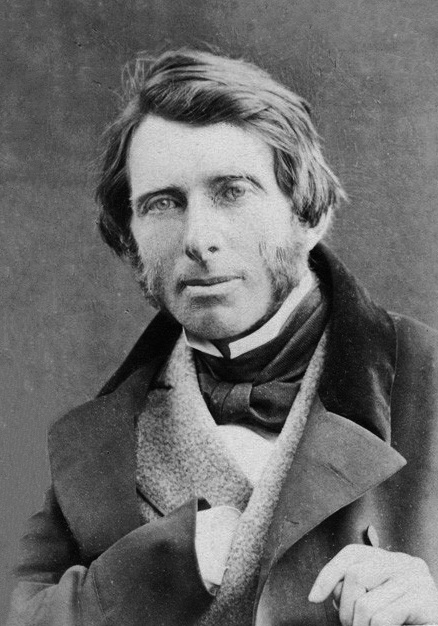
from https://commons.wikimedia.org…
John Ruskin 1863
- Public Domain photo of John Ruskin, 29 June 1863, by William Downey (1829-1915).
Added by
Simon Cotterill

from https://commons.wikimedia.org…
Portrait of John Ruskin - wood engraving c.1860
- Public Domain image from The Welsh Portrait Collection at the National Library of Wales c/o Wikimedia Commons.
Added by
Simon Cotterill
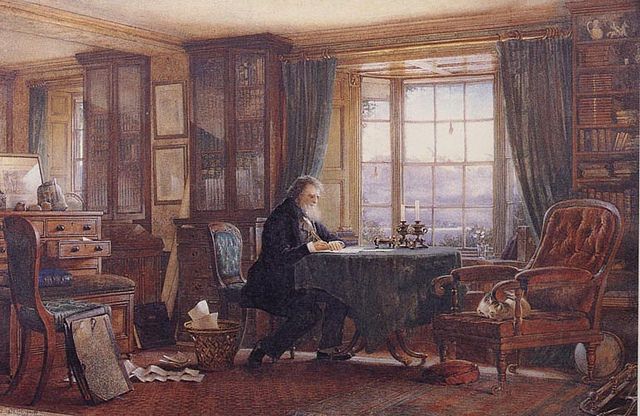
from Flickr (flickr)
William Gershom Collingwood - John Ruskin at Work in his Study
Pinned by Simon Cotterill
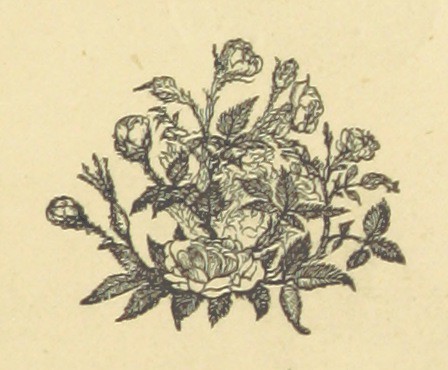
from Flickr (flickr)
Image taken from page 7 of 'The Works of John Ruskin'
Pinned by Simon Cotterill
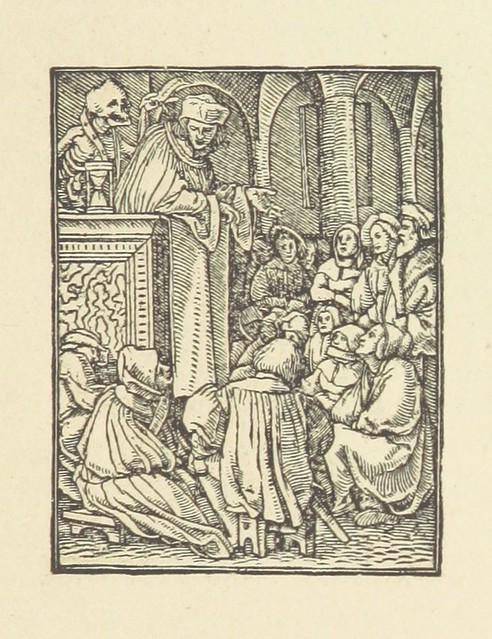
from Flickr (flickr)
Image taken from page 113 of 'The Works of John Ruskin'
Pinned by Simon Cotterill

from Flickr (flickr)
Four Volume Set of Stones of Venice in the AGA library
Pinned by Simon Cotterill
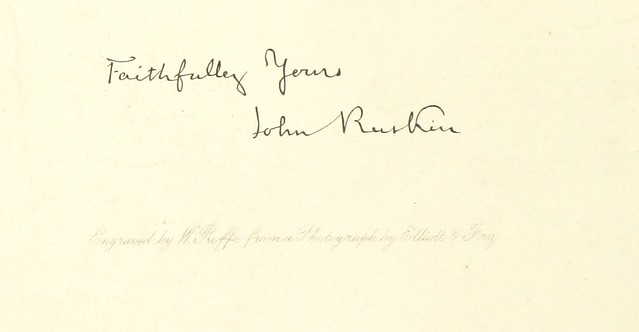
from Flickr (flickr)
Image taken from page 10 of 'The Ruskin Birthday Book. A selection ... from the works of J. Ruskin ... Collected and arranged by M. A. B. [i.e. Maud A. Bateman] and G. A. [i.e. Grace Allen.]'
Pinned by Simon Cotterill


from https://commons.wikimedia.org…
John Ruskin 1863
- Public Domain photo of John Ruskin, 29 June 1863, by William Downey (1829-1915).
Added by
Simon Cotterill

from https://commons.wikimedia.org…
Portrait of John Ruskin - wood engraving c.1860
- Public Domain image from The Welsh Portrait Collection at the National Library of Wales c/o Wikimedia Commons.
Added by
Simon Cotterill

from Flickr (flickr)
William Gershom Collingwood - John Ruskin at Work in his Study
Pinned by Simon Cotterill

from Flickr (flickr)
Image taken from page 7 of 'The Works of John Ruskin'
Pinned by Simon Cotterill

from Flickr (flickr)
Image taken from page 113 of 'The Works of John Ruskin'
Pinned by Simon Cotterill

from Flickr (flickr)
Four Volume Set of Stones of Venice in the AGA library
Pinned by Simon Cotterill

from Flickr (flickr)
Image taken from page 10 of 'The Ruskin Birthday Book. A selection ... from the works of J. Ruskin ... Collected and arranged by M. A. B. [i.e. Maud A. Bateman] and G. A. [i.e. Grace Allen.]'
Pinned by Simon Cotterill
